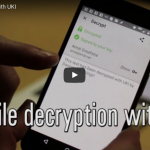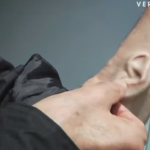Body implants
10 of the crazi

By Kristen V. Brown, Fusion From Business Insider
Cyborgs are not science future; sophisticated chips and sensor implants that merge man with machine are already here. There are people walking around with magnets in their finger tips andLED lights under their skin.
Here are some of the craziest ways that artists and technologists have hacked the human body (at least so far).
1. The artist with a magnetic chip to feel earthquakes
Spanish avant-garde artist Moon Ribas wanted to harness the power of technology to put her in better touch with the earth, so she got a subdermal implant near the bend of her elbow that is connected to an app on her iPhone that tracks seismic activity. When an earthquake happens, her implant vibrates in accordance with the strength of the quake, and she then translates the feeling of the vibration into a dance.
“The planet moves, constantly shaking and moving everyday,” Ribas, a choreographer, told Quartz. “I thought it would be amazing to translate the massive and natural movements of the planet in a different way.”
2. The guy who implanted an ear on his arm
Youtube via Mannet Villariba
The performance artist Stelarc dreamed of one day turning his body into a remote listening device that could transmit his surroundings to others around the world. So last year Stelarc underwent surgery to have a cell-cultivated ear attached to his left arm. Eventually, he plans to make the ear internet-connected, and outfitted with a miniature microphone that can wirelessly transmit audio from his arm to the rest of the world.
3. A techie with a cryptographic key in his wrist
Initially, all Amal Graafstra wanted was a way to quit carrying around a bunch of keys. But recently Graafstra, founder of biohacking company Dangerous Things, developed an implant designed to merge his digital and biological selves.
He implanted a small, NFC-compliant security chip containing cryptographic keys into his wrist, allowing him to use his body for things like file decryption and two-factor authentication. Eventually, he imagines the technology could also act as a digital wallet or replace things like transit tickets. “The ability for you to own your identity versus Facebook owning it all comes down to cryptography,” he told Motherboard.
4. A color-blind man with an antenna in his head that hears color
Neil Harbisson is a cyborg who can hear color through his antenna.Will Wei, Business Insider
Artist and cyborg activist Neil Harbisson can’t see color, but thanks to an antenna planted into his head, he can hear them. His antenna is connected to a chip that translates colors it perceives via camera into sound by converting them into different frequencies that vibrate inside of his skull. The antenna even allows Harbisson to perceive colors beyond the usual human spectrum, like infrared and ultraviolet. The antenna Harbisson says, has become a permanent part of his body—he even wears it in his passport photo.
5. A salesman with headphones implanted in his ears
William Brawley/flickr
Utah biohacker and salesman Rich Lee wanted the ability to listen to music on the sly. So back in 2013, he implanted permanent earbuds that can do just that. He implanted small magnets under the skin of his tragus, the small inner flap of his ear. He can play music to an audio player connected to a loose magnetic coil around his neck; it creates a magnetic field that causes the implants to vibrate and produce sound. Music, though, was only the beginning of what he hoped to do with it.
“I can see myself using it with the GPS on my smartphone to navigate city streets on foot,” he wrote. “I plan to hook it up to a directional mic of some sort (possibly disguised as a shirt button or something) so I can hear conversations across a room.” It’s unclear whether he ever took his bionic ears to the next level; instead his attentions shifted to other parts of the body. In 2014, he introduced the Lovetron9000, an implant he hopes will turn his man parts into a bionic, vibrating penis.
6. A photographer with a camera in his skull
Professor Lee Berger holds a replica of the skull of a newly discovered ancient species, named “Homo naledi”, during its unveiling outside JohannesburgThomson Reuters
For many photographers, the camera feels like an extra appendage. For, photographer and NYU professor Wafaa Bilal, his camera literally was one. For a project titled “3rd I,” Bilal had a camera implanted into the back of his head, allowing visitors to Qatar’s Arab Museum of Modern Art to enjoy a live stream of images of the parts of his own life that even Bilal himself couldn’t see. The project though, was not without uncomfortable complications: after just a few months, health problems forced him to have part of the camera removed.
7. A biohacker with a body temperature-reading Bluetooth chip
Back in 2013, biohacking pioneer Tim Cannon implanted a bulky, Bluetooth-enabled chip into his arm to monitor his vital signs. The implant could record data from Cannon’s body and transfer it to any Android-powered device—allowing him to program his phone to say, send him a text if he had a fever. Since then implants have gotten a lot smaller, and Cannon, who runs a company that makes implants, has kept on hacking.
8. Soldiers with brain chips
A. Ertürk, C. Pan, R. Cai, F. Quacquarelli, and A. Ghasemi/Nature Methods
One day, the Department of Defense’s research arm, DARPA, hopes that it will be able to heal the wounds of war byimplanting chips into soldiers’ brains that directly interfere with the brain signals that cause conditions like PTSD. In the meantime, the agency has already begun implanting temporary test devices into the brains of volunteers already undergoing brain surgery. Within the next few years, the agency aims to have a permanent chip developed.
9. A professor and his wife with implants that let them feel each others’ movements
Kevin Warwick is the Godfather of the biohacker movement. In 1998 Warwick, a professor of cybernetics at Reading University, became the world’s first cyborg when he had a radio frequency identification chip inserted into his left arm that allowed him to use his body to do things like open doors and switch on lights. Later, he had a microchip surgically implanted into his arm that connected to his nervous system, allowing him to essentially plug his body into a computer and do things like operate a robotic arm on another continent just by moving his own arm.
Warwick had a similar chip implanted into his wife, Irena. The implants connected the couple to each other, so that every time one of them moved their hand, the other felt a pulse. “It was the first time humans had ever communicated brain-to-brain,” Warwick told the Pittsburgh Post-Gazette. “We were able to communicate without speaking.”
10. Every lady with an IUD
Liz Henry/flickr
Women, of course, are the original biohackers. Something like 10 percent of women in the US have an IUD, a small t-shaped piece of metal or plastic with the ability to control our biology with incredible success.
“I can unlock my phone with my hand. It’s a nice party trick. But my IUD gives me a far more powerful type of control, and is a far more important part of my cyborg life,”Rose Eveleth wrote here at Real Future earlier this year. “Outside the movies and hand-wringing found in the press, women are hacking ourselves all the time.”
Read the original article on Fusion. Copyright 2016. Follow Fusion on Twitter.
IMAGE: neil harbisson Ints Kalnins/Reuters
For more on this story and video go to: http://www.businessinsider.com/10-of-the-craziest-things-people-have-implanted-in-their-bodies-2016-9?utm_source=feedburner&%3Butm_medium=referral&utm_medium=feed&utm_campaign=Feed%3A+businessinsider+%28Business+Insider%29/#1-the-artist-with-a-magnetic-chip-to-feel-earthquakes-1














